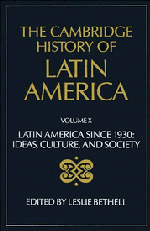Book contents
- Frontmatter
- 1 The multiverse of Latin American identity, c. 1920–c. 1970
- 2 Latin American narrative since c. 1920
- 3 Latin American poetry, c. 1920–1950
- 4 Latin American poetry since 1950
- 5 Indigenous literatures and cultures in twentieth-century Latin America
- 6 Latin American music, c. 1920—c. 1980
- 7 Latin American architecture, c. 1920–c. 1980
- 8 Latin American art since c. 1920
- 9 Latin American cinema
- 10 Latin American broadcasting
- Bibliographical essays
- References
9 - Latin American cinema
Published online by Cambridge University Press: 28 March 2008
- Frontmatter
- 1 The multiverse of Latin American identity, c. 1920–c. 1970
- 2 Latin American narrative since c. 1920
- 3 Latin American poetry, c. 1920–1950
- 4 Latin American poetry since 1950
- 5 Indigenous literatures and cultures in twentieth-century Latin America
- 6 Latin American music, c. 1920—c. 1980
- 7 Latin American architecture, c. 1920–c. 1980
- 8 Latin American art since c. 1920
- 9 Latin American cinema
- 10 Latin American broadcasting
- Bibliographical essays
- References
Summary
introduction: the silent era
With the advent of the centenary of cinema, each country has a story to tell about the arrival of moving pictures in the last decade of the nineteenth century. On 6 August 1896, in Mexico, C. F. Bon Bernard and Gabriel Veyre, agents of the Lumiere brothers, showed the President of Mexico, General Porfirio Diaz and his family the new moving images. Three weeks later they gave public screenings. And they began to film the sights of Mexico, in particular those in power in the land: Diaz on his horse in Chapultepec Park, Diaz with his family, scenes from the Military College. At the end of the year Veyre left Mexico and arrived in Cuba on 15 January 1897. He set up in Havana, at 126 Prado Street, and a few days later the local press announced screenings in the Parque Central alongside the Tacón theatre. Particular favourites were the ‘Arrival of the Train’, ‘The Puerta del Sol Square in Madrid’ and ‘The Arrival of the Czar in Paris’. Veyre went down to the fire-station in Havana to film the activities there. He took along with him Maria Tubau, a Spanish actress who was the star of the theatre season. It is said that she wanted to see the fireman at work. What is more likely is her early fascination with a medium, still in its infancy—the shots of the firemen last one minute— which would incorporate theatre and its forms into a new language.
- Type
- Chapter
- Information
- The Cambridge History of Latin America , pp. 455 - 518Publisher: Cambridge University PressPrint publication year: 1995



